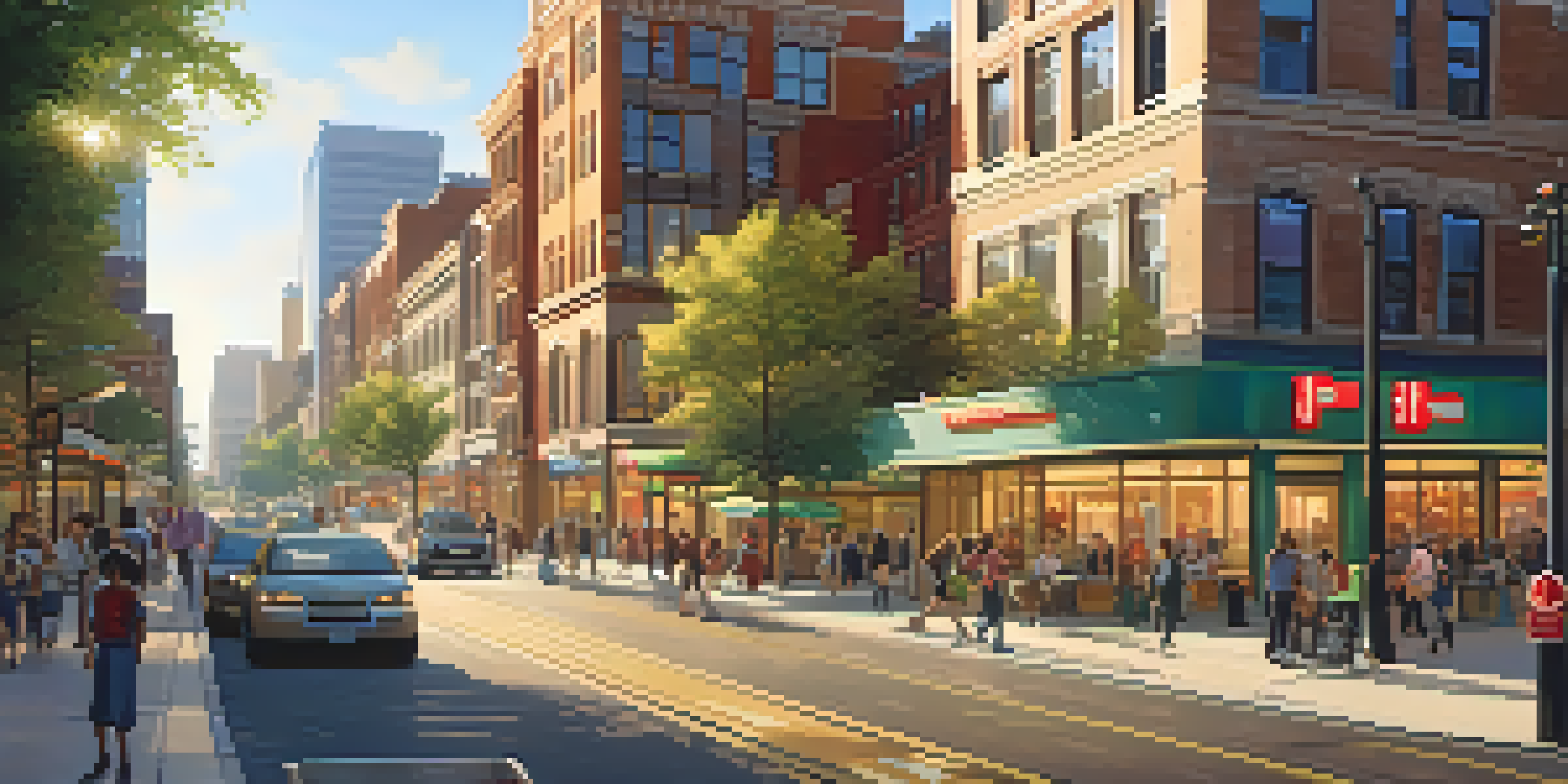How the Real Estate Market Reacts to Location Changes

The Significance of Location in Real Estate Valuation
Location is often cited as the most crucial factor in real estate. It affects property value, demand, and even the type of buyers interested in a property. For example, homes near schools or parks typically fetch higher prices due to the desirability of those amenities.
Location, location, location. It’s the mantra of real estate for a reason.
When a neighborhood undergoes changes, such as new developments or infrastructure improvements, it can significantly alter its appeal. A once-quiet area might become bustling with new businesses, leading to a surge in property demand. Conversely, a neighborhood that sees an influx of crime or neglect can see values plummet.
Ultimately, understanding how location influences real estate is key for investors and homeowners alike. It underscores the importance of staying informed about local trends and developments that could impact property values.
How Infrastructure Developments Affect Property Values
Infrastructure changes, such as new roads, public transit, or parks, can dramatically impact property values. For instance, a new subway line can make previously inaccessible neighborhoods attractive to buyers, boosting demand and prices in the area.

Moreover, improvements in infrastructure often lead to increased economic activity. Restaurants, shops, and services tend to follow, further enhancing the appeal of the location. This cycle can create a positive feedback loop, where rising property values attract more development.
Location Drives Real Estate Value
The location of a property significantly impacts its value, demand, and the types of buyers attracted.
Property owners should keep a close eye on infrastructure plans in their areas. Knowledge of upcoming projects can be a game-changer, providing opportunities for investment or timely sales before potential value increases.
The Role of Local Amenities in Driving Demand
Local amenities such as shopping centers, schools, and recreational facilities play a significant role in drawing buyers to a location. Properties near these conveniences often command higher prices as they offer a lifestyle that many seek.
The best investment on Earth is earth.
As new amenities are introduced, they can redefine a neighborhood's appeal. For example, the opening of a trendy coffee shop can attract young professionals, shifting the demographic and increasing demand for nearby housing.
Understanding the impact of amenities helps buyers and investors make informed decisions. By recognizing the value of amenities in a given area, one can better assess property potential and market trends.
Neighborhood Trends: Gentrification and its Impact
Gentrification is a complex phenomenon that can lead to significant shifts in real estate markets. While it often results in increased property values, it can also displace long-term residents and change the character of a neighborhood.
As new investments pour in, existing homeowners might find their properties appreciating rapidly, creating both opportunities and challenges. For some, this can be a windfall, while others may struggle with rising taxes and living costs.
Infrastructure Boosts Property Prices
Improvements in infrastructure, such as new roads or public transit, can enhance property values by increasing accessibility and local economic activity.
Understanding gentrification's dual nature is essential for anyone involved in real estate. It highlights the importance of community dynamics in shaping property values and market perceptions.
The Impact of Crime Rates on Property Values
Crime rates can heavily influence real estate market dynamics. Areas with lower crime rates tend to attract more buyers, increasing demand and property values over time. On the flip side, neighborhoods that experience rising crime often see property values decline as potential buyers shy away.
Real estate professionals often use crime statistics as a key indicator when assessing property values and market trends. A sudden spike in crime can lead to a swift decrease in interest, impacting sellers and investors alike.
For buyers, understanding the crime landscape in a potential neighborhood is crucial. It can guide decisions and ensure that investments are made in areas with a promising future.
Economic Factors and Their Influence on Real Estate
The local and national economy directly impacts real estate markets. When the economy is thriving, more people tend to buy homes, driving up demand and prices. Conversely, during economic downturns, buyers become more cautious, leading to stagnation or declines in property values.
Job growth in a particular area often correlates with increased housing demand. When companies expand or relocate, they bring jobs, attracting new residents who need places to live, thus boosting the local real estate market.
Local Amenities Shape Buyer Demand
Proximity to local amenities like schools and shopping centers plays a crucial role in attracting buyers and determining property prices.
Keeping an eye on economic indicators can provide valuable insights for real estate investors and homeowners. Understanding these trends helps in making informed decisions about buying, selling, or investing in property.
The Influence of Market Sentiment on Location Changes
Market sentiment, or how buyers and sellers feel about the real estate market, can greatly influence property values. Positive sentiment can lead to higher demand, while negative feelings can dampen interest, regardless of actual market conditions.
For instance, if a neighborhood is perceived as 'up-and-coming' due to media buzz or social media trends, it can lead to a rush of buyers eager to invest before prices rise. This perception can sometimes outpace actual developments in the area.

Understanding market sentiment allows real estate professionals to navigate the complexities of location changes effectively. By tapping into these collective feelings, they can better position themselves and their listings in the market.
Conclusion: The Ever-Changing Landscape of Real Estate
The real estate market is a dynamic entity, constantly influenced by location changes and various external factors. From infrastructure developments to shifts in local amenities, each element contributes to the overall appeal of a property.
For buyers, sellers, and investors, staying informed about these changes is crucial. It not only helps in making strategic decisions but also aids in understanding the broader market landscape.
Ultimately, recognizing the interconnectedness of these factors can lead to more successful real estate endeavors, whether you're looking to buy your first home or invest in rental properties.